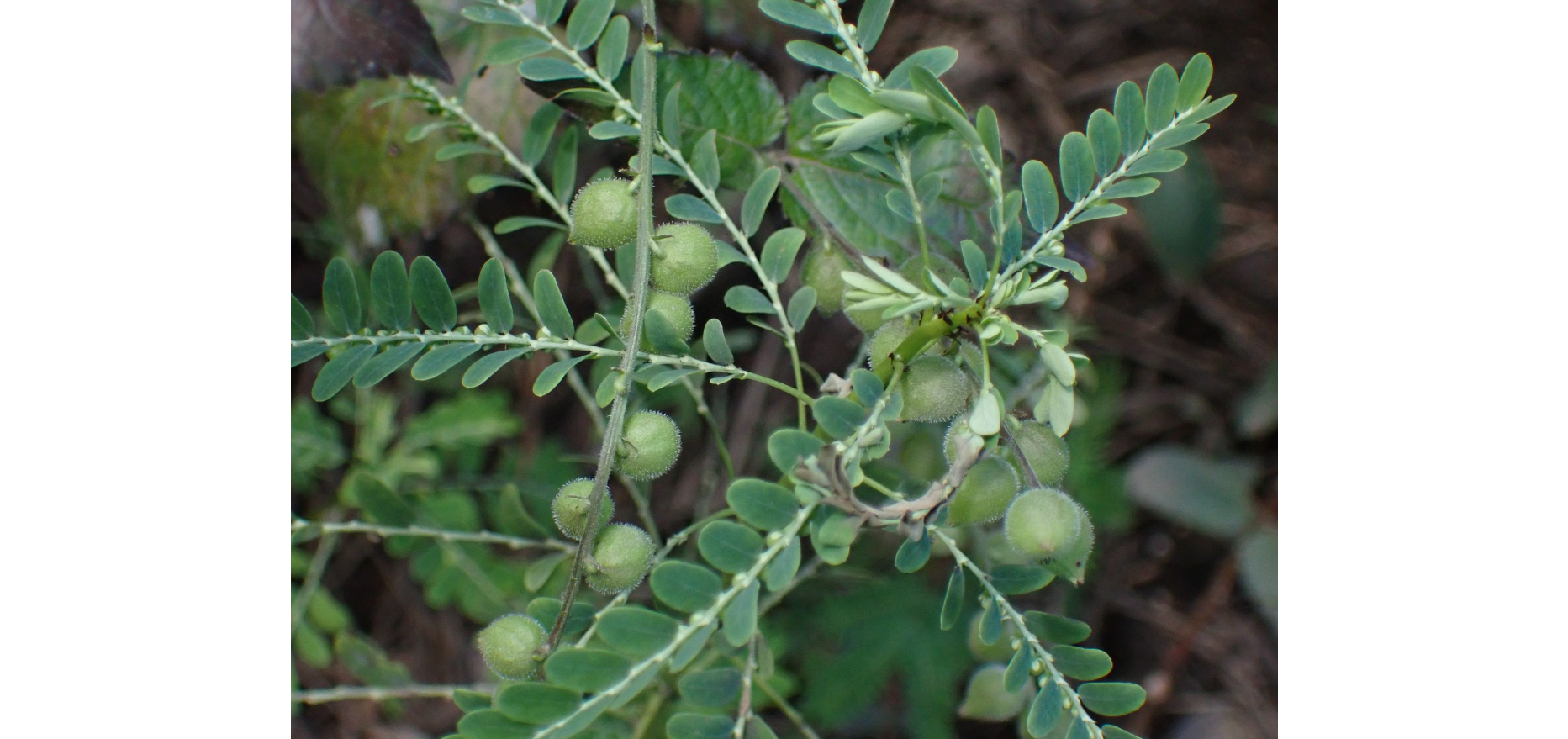Phyllanthus amarus

|
|
Phyllanthus amarus Common Names: Gale-O-Wind, Hurricane Weed,
Stonebreaker, Seed-under-leaf Scientific
Classification Kingdom: Plantae Clade: Angiosperms Clade: Eudicots Order: Malpighiales Family: Phyllanthaceae Genus: Phyllanthus Species: P. amarus Synonyms: Phyllanthus amarus Schumach. & Thonn., Phyllanthus niruri sensu auct. (misapplied), Phyllanthus fraternus Webster Morphological Description Phyllanthus amarus is an erect, annual herb typically growing to 10–60 cm in
height, though it can reach up to 70 cm under favorable conditions. Its key
morphological features include: · Stem: Slender, terete, smooth or slightly scabridulous in younger
parts, often branching profusely · Leaves: Alternate, elliptic to oblong, 3–11 mm long and 1.5–6 mm
wide, with an entire margin, rounded or minutely apiculate apex, and slightly
inequilateral base; petioles short (0.3–0.5 mm) · Flowers: Monoecious, incomplete, actinomorphic, arranged in small
axillary cymes; male flowers with 5–6 tepals (1–1.5 mm), female flowers
slightly larger; greenish-yellow in color · Fruit: Three-lobed capsule, 1.5–2 mm in diameter, smooth, green
turning brown at maturity, containing 6 trigonous seeds The plant’s delicate
structure and small size make it easily overlooked, yet its reproductive
efficiency contributes to its widespread distribution (Patel et al., 2011). Distribution and Habitat Phyllanthus amarus is a pantropical species thriving in tropical and
subtropical regions globally (latitudes 35°N–35°S). Its origins are debated,
with some suggesting the Caribbean or southern United States as its native
range, from where it spread via human activity (Unander et al., 1995). It is
now documented in: · Americas: Bahamas, Brazil, Mexico (sea level to 1,000 m) · Africa: Nigeria, Ghana, South Africa (annual rainfall 500–1,500 mm) · Asia: India, Philippines, Thailand (up to 1,200 m altitude) It prefers disturbed
habitats such as roadsides, gardens, fields, and waste lands, thriving in
well-drained, sandy-loam soils (pH 5.5–7.0) and temperatures of 20–35°C (Useful
Tropical Plants, n.d.). Ethnopharmacology Phyllanthus amarus has a rich history in traditional medicine across cultures,
supported by ethnopharmacological studies: · Hepatoprotective: In Nigeria, the whole plant is boiled and
consumed to treat jaundice and liver disorders; a study showed its aqueous
extract reduced aflatoxin B1-induced liver damage in mice by 60% at 200 mg/kg
(Naaz et al., 2007). · Antiviral: In India (Ayurveda), it’s used for hepatitis B; ethanol
extracts inhibited HBV DNA polymerase by 85% at 100 μg/ml in vitro
(Venkateswaran et al., 1987). · Diuretic: In Ghana, leaf infusions treat urinary issues; a rat study
confirmed a 40% increase in urine sodium excretion at 300 mg/kg (Yao et al.,
2018). · Antidiabetic: In the Bahamas, it’s a tea for diabetes; ethanol leaf
extract reduced blood glucose by 35% in alloxan-induced diabetic mice at 400
mg/kg (Shetti et al., 2012). · Antibacterial: In Brazil, it treats gastrointestinal infections; methanol
extracts showed a minimum inhibitory concentration (MIC) of 62.5 μg/ml
against Escherichia coli (Mazumdar Ghosh et al., 2022). Medicinal Properties Phyllanthus amarus’s is renowned for its
extensive medicinal properties and widespread use in traditional medicine
systems across the globe. It is characterized by a bitter and astringent taste
and is traditionally employed as a stomachic, diuretic, febrifuge, and
antiseptic agent. The entire plant has been utilized to address conditions such
as gonorrhea, menorrhagia, and various genital afflictions. Phytochemical
analyses have identified a diverse array of bioactive compounds within P.
amarus, including flavonoids (e.g., quercetin-3-O-glucoside, rutin), tannins
(e.g., geraniin, amariin, gallocatechin), and alkaloids (e.g., phyllanthin,
securinine). These constituents contribute to the plant's broad pharmacological
profile, which encompasses hepatoprotective, antioxidant, antiviral, antimicrobial,
antidiabetic, anti-inflammatory, anticancer, antimalarial, nephroprotective,
and diuretic activities. In Ayurvedic medicine, P. amarus is traditionally used
to treat ailments related to the stomach, genitourinary system, liver, kidneys,
and spleen. Modern scientific investigations have provided evidence supporting
several of these traditional uses. For example, studies have demonstrated the
plant's hepatoprotective effects, suggesting potential benefits in managing
liver disorders. Additionally, its anti-inflammatory properties have been
substantiated, indicating its usefulness in treating inflammatory conditions.
Furthermore, P. amarus has shown promise in antiviral applications,
particularly against hepatitis B virus, aligning with its traditional use in
treating jaundice and other liver-related ailments. Its antidiabetic potential
has also been explored, with findings indicating its ability to lower blood
glucose levels, thereby supporting its use in managing diabetes. While these findings underscore the
therapeutic potential of Phyllanthus amarus, it is essential to approach its
use with caution. Further research is necessary to fully elucidate its
efficacy, safety profile, and possible interactions with conventional
medications. Consultation with healthcare professionals is recommended before
incorporating P. amarus into therapeutic regimens. · Antioxidant: Contains flavonoids (e.g., quercetin, rutin) and tannins
(e.g., geraniin), reducing DPPH radicals by 78% at 50 μg/ml (Londhe et al.,
2008). · Anti-inflammatory: Lignans like phyllanthin inhibit paw edema
in rats by 45% at 20 mg/kg (Kassuya et al., 2005). · Anticancer: Aqueous extracts reduced tumor growth in mice by 52% at 200
mg/kg, linked to apoptosis induction (Rajeshkumar et al., 2002). · Radioprotective: Protected rat liver mitochondria from
gamma radiation damage by 65% at 100 mg/kg (Guha et al., 2010). ⚠ Toxicity Profile: While beneficial, Phyllanthus amarus contains compounds like phyllanthin and
hypophyllanthin with potential toxicity. Chronic intake (>1 g/kg daily) in
rats caused neurotoxicity (altered motor activity) and hepatotoxicity (elevated
ALT by 30%) due to mitochondrial inhibition (Adeneye et al., 2008). Human
studies are limited, urging cautious use. Additional Uses · Nutrition: Leaves contain 2.5% protein, 15% carbohydrates, and minerals
(Mn: 0.8 mg/100g, Cu: 0.3 mg/100g, Zn: 1.2 mg/100g) (Leon Levy Native Plant
Preserve, 2024). · Ecological: Acts as a pioneer species in disturbed soils, aiding
revegetation. · Cultural: Used in rituals in some African communities for its
perceived protective properties. References
External Links More Pictures
|
|
| Compounds of Phyllanthus amarus |
|
| References |